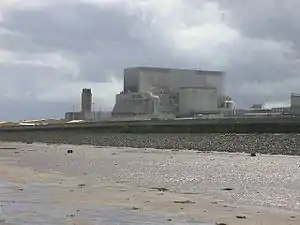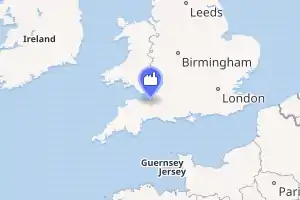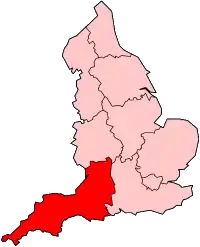Hinkley Point B nuclear power station
Hinkley Point B nuclear power station is a nuclear power station near Bridgwater, Somerset, on the Bristol Channel coast of south west England. It was the first commercial Advanced Gas Cooled reactor to generate power to the National Grid in 1976 and shares its design with sister station Hunterston B nuclear power station.
| Hinkley Point B nuclear power station | |
|---|---|
 Hinkley Point B seen from the beach | |

| |
| Country | England |
| Location | Somerset, South West England |
| Coordinates | 51.209034°N 3.127477°W |
| Status | Operational |
| Construction began | 1967 |
| Commission date | 1976 |
| Decommission date | Expected by July 2022 |
| Owner(s) | Central Electricity Generating Board (1976–1989) Nuclear Electric (1989–1996) British Energy (1996–2009) EDF Energy (2009–present) |
| Operator(s) | EDF Energy |
| Nuclear power station | |
| Reactor type | AGR |
| Reactor supplier | Whessoe and Strachan & Henshaw (Graphite supplied by Anglo Great Lakes Corporation Ltd) |
| Cooling source | Severn Estuary |
| Thermal capacity | 2 x 1494 MWt |
| Power generation | |
| Units operational | 2 x 655 MWe (Operating at ~475 MWe[1] ) |
| Make and model | General Electric Company |
| Nameplate capacity | 1310 MW |
| Annual net output | 7,202 GW·h |
| External links | |
| Website | www |
| Commons | Related media on Commons |
grid reference ST211460 | |
History
The construction of Hinkley Point B, which was undertaken by a consortium known as The Nuclear Power Group (TNPG),[2] started in 1967. The reactors vessels were supplied by Whessoe, reactor machinery was supplied by Strachan & Henshaw and the turbines by GEC.[3]
In March 1971 it was announced that there would be a six-month delay in completion due to problems with the insulation of the concrete pressure vessel. In place of the stainless steel mesh and foil insulation that had been used on previous Magnox stations, a fibrous type of insulation supplied by Delaney Gallay, part of the Lindustries Group, had been used for the first time. During pre-operational trials, before the nuclear fuel was loaded, high levels of acoustic vibration in the gas circuit were found to be damaging the insulation tiles, and the retention plates which held the insulation in place had to be redesigned and modified within the reactor.[4]
During further pre-operational testing, severe vibration of the fuel channel gags was detected. The fuel channel gags are valves which are gradually closed to restrict the flow of gas through a fuel channel in order to maintain the channel gas outlet temperature as the nuclear fuel is used up. Modifications to produce a fluidically generated bias force to stop the gags vibrating took time to design, test and implement, delaying the planned start up date.[5] The station began generating electricity on 5 February 1976.
It was taken over by Nuclear Electric as part of the privatisation of the UK Electricity Supply Industry in 1990, though remaining in public ownership at that time. In 1996, the AGR and PWR assets of Nuclear Electric and Scottish Nuclear were privatised as part of British Energy.
In 2006 the station's reactors were shut down in order to inspect the boilers for microscopic weld defects that had been found in power stations using similar boiler designs. While it was implied in the media that these were major holes gushing steam, had this been the case the loss of pressure would lead to an automatic shut down to prevent damage. Due to its age, on 16 August 2006 the company warned that until a decision was made over whether to extend its usable life it would operate at a maximum of 70 per cent load. Both reactors were subsequently restarted generating 420 MW each, roughly 70% of full capacity. The number 4 reactor was cleared for restart by the Nuclear Installations Inspectorate on 11 May 2007. [6] The power station's current accounting closure date is 2023.[7]
In July 2013, EDF Energy announced that the load on both of the station reactors had been increased to 80 per cent, resulting in an output of around 485-500MWe per reactor up from 70 per cent load, where it had been generating around 420MWe per reactor since 2006.[8]
Hinkley Point B is the only one of four nuclear power stations in the area which is operational, the others being decommissioned are the adjacent Hinkley Point A together with Oldbury and Berkeley on the banks of the River Severn.
In October 2016 it was announced that super-articulated control rods would be installed in the reactor because of concerns about the stability of the reactors' graphite cores. The Office for Nuclear Regulation (ONR) had raised concerns over the number of fractures in keyways that lock together the graphite bricks in the core. An unusual event, such as an earthquake, might destabilise the graphite so that ordinary control rods that shut the reactor down could not be inserted. Super-articulated control rods should be insertable even into a destabilised core.[9]
Specification
The station is of the advanced gas-cooled reactor (AGR) type with two 1600 MWt reactors, each with their own 660 MWe steam turbine generator set giving a combined maximum design generating capacity of 1250 MW. As of 2013 it provided over 1% of the UK's total power output.[10]
Comparison With Hinkley Point A
A comparison With Hinkley Point A is shown below.[11] See also comparison of Hinkley Point A, B and C
| Parameter | Hinkley Point B | Hinkley Point A |
|---|---|---|
| Output of Main Turbines | 2 x 660 MW 1250 MW | 6 x 93.5 MW 500 MW |
| Area of Main Station | 8.1 ha (20 acres) | 16.2 ha (40 acres) |
| Fuel Per Reactor | 122 t (120 tons) | 355 t (349 tons) |
| Fuel | Uranium Oxide slightly enriched in ceramic form | Natural Uranium |
| Fuel Cans | Stainless Steel | Magnox |
| Fuel Surface Temperature | about 825 Degrees Celsius | about 430 Degrees Celsius |
| CO2 Pressure | 41.4 bar g (600 lb/in2 g) | 12.7 bar g (185 lb/in2 g) |
| CO2 Channel Outlet Temperature | 665 Degrees Celsius | 387 Degrees Celsius |
| Number of Channels per Reactor | 308 | 4500 |
| Total Weight of Graphite per Core | 1199 t (1180 tons) | 1891 t (1861 tons) |
| Steam Conditions Turbine Stop Valve HP | 160 bar g (2318 lb/in2 g) 538 Degrees Celsius | 45.5 bar g (660 lb/in2 g) 363 Degrees Celsius |
| Steam Conditions Turbine Stop Valve IP/Reheat | Reheat 38.9 bar g (565 lb/in2 g) 538 Degrees Celsius | IP 12.7 bar g (183 lb/in2 g) 354 Degrees Celsius |
Capacity and output
The generating capacity, electricity output, load factor and thermal efficiency was as shown in the table.[12]
| Year | Net capability, MW | Electricity supplied, GWh | Load as percent of capability, % | Thermal efficiency, % |
|---|---|---|---|---|
| 1979 | 932 | 3,342.941 | 63.8 | 35.23 |
| 1981 | 1134 | 5,540.628 | 62.6 | 37.17 |
| 1982 | 1134 | 5,810.483 | 63.8 | 37.22 |
| 1984 | 1040 | 7,406.767 | 81.1 | 37.68 |
Future of the station
On 19 November 2020, EDF announced that Hinkley point B will stop generating electricity and move into the defuelling phase no later than 15 June 2022.
"Running a nuclear power plant this efficiently for over 40 years leads to changes in the reactors. Our inspections of Hinkley’s reactor cores this year show that the graphite blocks are in exactly the sort of condition we predicted they would be at this stage in the station’s lifetime. As a responsible operator we feel it is now the right thing to do to give clarity to our staff, partners and community about the future life of the station, which is why we have made this proactive decision. I would like to pay tribute to all those associated with Hinkley Point B for their outstanding professionalism and wish them well with the next chapter."
— Matt Sykes, Managing Director of EDF Generation
EDF had originally hoped to operate the plant into March 2023. The plant has operated for 45 years and has produced over 300TWh over its lifetime.[13][14]
Proposed Hinkley Point C
A new 3,260 MW Hinkley Point C nuclear power station, consisting of two EPR reactors, was given planning consent on 19 March 2013.[15] A guaranteed "strike price" of £92.50 per megawatt-hour (to be indexed for inflation over 45 years) was announced on 21 October 2013. The new power station would see Hinkley's contribution to the country's power supply rise to 7%.[10] At the time of the planning consent, the price for electric energy on the wholesale market was around £45 per megawatt-hour while the new power plant was expected to need earnings of £90 per megawatt-hour in order to break even.[16]
The EU gave (8 October 2014) its consent to the 'Contract for Difference (CFD)' that guarantees the "strike price".[17] Greenpeace Energy have announced that they have mandated 'Becker Büttner Held' to file a lawsuit against the EU commission.[18]
References
- "Hinkley Point B EDF Energy". Retrieved 14 October 2014.
- "Nuclear Development in the United Kingdom". World Nuclear Association. Retrieved 28 December 2013.
- "Nuclear Power Plants in the UK". Industcards.com. Archived from the original on 19 July 2009. Retrieved 20 October 2013.
- The Times, Tuesday, 30 March 1971
- The Times, Thursday, 13 February 1975
- "Nuclear plant gets nod to restart". BBC. 11 May 2007. Retrieved 31 May 2007.
- EDF Energy WCM (4 December 2012). "EDF Energy announces seven year life extension to Hinkley Point B and Hunterston B nuclear power stations – EDF Energy 4 December 2012". Edfenergy.com. Archived from the original on 20 October 2013.
- "Hinkley Point B and Hunterston B return to 80% load". NucEngInt. 1 July 2013. Retrieved 12 May 2015.
- "Nuclear reactor cracks 'challenge safety case'". BBC News. 31 October 2016. Retrieved 31 October 2016.
- "UK nuclear power plant set for go-ahead". bbc.co.uk. 13 October 2013. Retrieved 20 October 2013.
- Hinkley Point B Nuclear Power Station. Information Services, Sudbury House, 15 Newgate Street, London EC1 7AU: Central Electricity Generating Board. April 1971. p. 4.CS1 maint: location (link)
- CEGB Statistical Yearbook 1979-84, CEGB London
- "UK's most productive nuclear power station to move into decommissioning by July 2022". EDF Energy. EDF Energy. 19 November 2020. Retrieved 19 November 2020.
- "UK's Hinkley Point B to be retired by July 2022". World Nuclear News. 19 November 2020. Retrieved 19 November 2020.
- Harvey, Dave Harvey (19 March 2013). "What price nuclear power? The final hurdle for Hinkley". BBC. Retrieved 19 March 2013.
- What price nuclear power? The final hurdle for Hinkley BBC, 19 March 2013.
- State aid: Commission concludes modified UK measures for Hinkley Point nuclear power plant are compatible with EU rules
- 12 March 2015: BBH bereitet Klage gegen EU-Kommission vor Archived 12 April 2015 at the Wayback Machine
| Wikimedia Commons has media related to Hinkley Point B Nuclear Power Station. |
